 |
1.
Challenging to ‘Our’ low-birth-rate-hyper-aging-society
:Japanese government, health sectors, and citizen
Mitsuho Ikeda
Center for the Study of Communication-Design,CSCD
Osaka University
November 8, 2015
Workshop of the Governmental Health Policy and Social Responses in East
Asian Countries, sponsored of the Japanese Society for Promotion of
Sciences, JSPS
|
 |
2.
outline of my presentation
We will have three parts of this presentation
1) General description on Aging Society, “Kōreika-Shakai” and Policy of
Japan
2) Structural Violence toward foreign ‘Newcomers’ workers in Japan
3) How we should do? :Methodological memorandum
|
 |
3.
Government Political Issues
Rapid Demographic Change
Labor Force Population Problem
High Working Motivation among Elderly
Revisions to the Act on Employment for Elderly
Eligibility Age for the Employee Pensions
Mandatory Retirement System
Silver Human Resource Center
Steering for Active Healthy Aging Policy
Techno-phile Policy: Public Investments of High-Technologies for
Elderly more than human capacitation
|
 |
4.
Demographic Change in Japan
(Source: Ministry of Health, Labour and Welfare, 2012)
|
 |
5.
Rising of Eligibility Age for Employee Pension
(Source: Ministry of Health, Labour and Welfare, 2012)
|
 |
6.
Structural Violence Toward Foreign “Newcomers” Workers in Contemporary
Japan: An Anthropological Approach to Health care, Welfare and
Low-intensity Conflict
|
 |
7.
Outline of this part
What is foreign laborer as workforce?
Why does Japan accept foreign workforce not human worker?
What is Structural Violence?
Structural Violence toward foreign workers?
Making social safety network for foreign medical/health workers
|
 |
8.
What is foreign worker ?
In Japan; Other, foreign immigrant workers with working visa, and
“technical intern trainee” and “trainee.”
In developed countries; Other, foreign immigrant workers with working
visa and illegitimate worker.
In developing countries; Stakeholders themselves who want to work
abroad with various motivations.
|
 |
9.
Migration Flows:
Source: http://search.credoreference.com/content/topic/immigration
|
 |
10.
Official Announcement for acceptance of “good” Foreigners
(Ministry of Foreign Affair of Japan and Immigration Bureau, Ministry
of Justice)
Promotion for Inbound Tourism(“Kankō-Rikkoku”)
Acceptance of Skilled Laborer
“Respondence” for inland working population decline
“Reducing by half” of illegal overstayers and “confirming refused
entry” against persona non grata like terrorists in terms of “good and
short” circulation of foreign tourists and short term skilled laborers
|
 |
11.
Logic of Sustainability for Aged Welfare Care
|
 |
12.
From Volunteer Translators’ Experiences
in health care setting
Even though establishment of official guideline of the curriculum in
March 2014, many health/medical translators are working as
semi-authorized volunteers in health care setting.
According interviews with translators, we can get the picture of
interactions between foreign workers and translators not only in
various health care settings but also in various transcultural problems.
We can easily seize not only their health problems but also cultural
difference problems both as social sufferings.
We need to establish rescuing for the victims who are neglected from
human rights protection and to make a kind of social security network
by not only Japanese government but Japanese citizen ourselves.
|
 |
13.
Dilemma of making Our Multi-cultural/lingual society
Japanese society has tended to contributing international societies,
especially Southeast Asian Countries, e.g. ASEAN with various reasons
(e.g. war compensation, global economic expansion and ‘invasion,’ and
neoliberal free trade scheme)
But Japanese government still remains double standards of
‘internationalization’ between more open export our industrial products
and very close labour market system for foreign workers.
The latter causes “structural violence” potential toward foreign
workers in Japan, e.g. Technical Intern Training Program(TITP), Intern
Training Program(ITP).
|
 |
14.
What is Structural Violence?
Johan Galtung’s thesis (1969)
SV is “a form of violence wherein some social structure or social
institution may harm people by preventing them from meeting their basic
needs. Institutionalized adultism, ageism, classism, elitism,
ethnocentrism, nationalism, racism, and sexism are some examples of
structural violence” - Wikipedia
Galtung, Johan. “Violence, Peace, and Peace Research,” Journal of Peace
Research, 6(3):167-169 (1969)
|
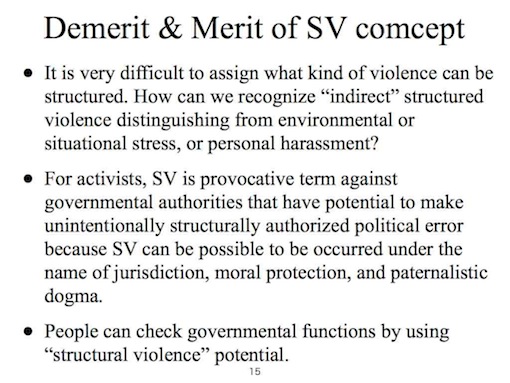 |
15.
Demerit & Merit of SV comcept
It is very difficult to assign what kind of violence can be structured.
How can we recognize “indirect” structured violence distinguishing from
environmental or situational stress, or personal harassment?
For activists, SV is provocative term against governmental authorities
that have potential to make unintentionally structurally authorized
political error because SV can be possible to be occurred under the
name of jurisdiction, moral protection, and paternalistic dogma.
People can check governmental functions by using “structural violence”
potential.
|
 |
16.
Xenophobic Structural Violence
It is not difficult to suggest that our government has had tendencies
xenophobic policy, especially disdain for Asian countries -
“Datsua-Nyūō”- from the birth of modern Japan, the Meiji
restoration ca.1868 to present.
In this historical scheme, our structural violence against foreign
workers can be criticized by both international societies and ourself
even though the government has introduced and continued problematic
TITP and ITP from 1990.
|
 |
17.
System of TITP/ITP
|
 |
18.
Problems of TITP/ITP system
|
 |
19.
Some examples of SV in TITP/ITP system
Prohibited mortgage and deposit collecting (Placement agencies in
emigration countries)
Opaque contract, management, and intermediation (Coordination agencies)
Nearly “slavery” labor in the name of “training, ” unpaid wedge (Actual
workshop or ‘Sweatshop’)
Direct violence, private sanctions, abuse, and sexual harassment
including rape. (Actual workshop)
Imposition of illegal “additional costs,” forced wedge savings, and
confiscation & deposit of passport from holders. (Actual
workshop)
|
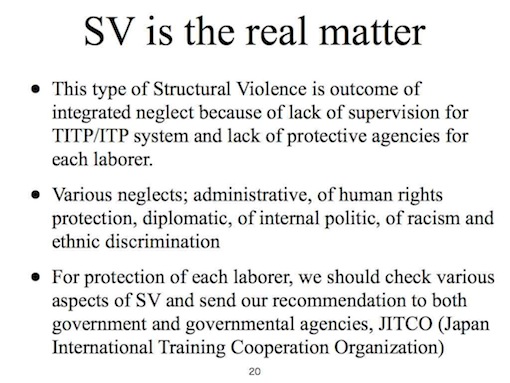 |
20.
SV is the real matter
This type of Structural Violence is outcome of integrated neglect
because of lack of supervision for TITP/ITP system and lack of
protective agencies for each laborer.
Various neglects; administrative, of human rights protection,
diplomatic, of internal politic, of racism and ethnic discrimination
For protection of each laborer, we should check various aspects of SV
and send our recommendation to both government and governmental
agencies, JITCO (Japan International Training Cooperation Organization)
|
 |
21.
Policing/Policizing Japan against FURYO-GAIJIN (bad foreigner)
"SHIZUOKA PREFECTURE has a history of singling out of foreign residents
for special treatment. One case was Rainichi Gaikokujin Hanzai no
Tokuchou (Characteristics of Crimes by Foreigners Coming to Japan),
published in February 2000 and distributed to shopkeepers and other
private businesses with tips on dealing with bad foreigner crime."
(Cited Japan Times, ca. 2007)
|
 |
22.
Japan International Cooperation Welfare Services, JICWELS
Now we remind EPA specialized Japanese agency, Japan International
Cooperation Welfare Services, JICWELS, July 1984-. This agency is only
monopolistic agency for EPA transactions and administrative stuffs have
‘parachuted’ (“Amakudari”) in from the Ministry of Health, Labour and
Welfare.
They say, “[W]e are designated by the Government of Japan as the only
acceptance agency for acceptance of foreign professionals, such as
nurses and care givers from Asian countries under the Economic
Partnership Agreement (EPA) between the Government of Japan and Asian
countries. We have started preparation for the to accept foreign
professionals since 2010.”
|
 |
23.
Making social safety network for foreign workers
On one side even the JICWELS which treats foreign health and welfare
‘professionals’ has a lot of reformative tasks in present, we should
focus on protecting ongoing EPA ‘candidates’ activities and their own
human rights as foreign workers in Japan on the other.
Present Japanese government hesitates acceptance ‘immigration’ by not
only presenting administrative policies but also avoiding officially
use of word of ‘immigration.’
Our tasks should be positioned in various areas; sociological and
anthropological analysis for migration of medical/health workers,
uncovering ‘structural violence’ aspects on medical/health workers,
making a proposal of reformative recommendation according our
investigation outcome for Japanese government and agency, and
organizing empowerment workshops for foreign medical/health workers in
Japan.
|
 |
24.
How we should do?: In Our Future of Hyper-Aging Society
|
 |
25.
What is EPA?
Economic Partnership Agreement
"An economic partnership agreement is an economic arrangement that
eliminates barriers to the free movement of goods, services, and
investment between countries. This agreement can be considered an
intermediate step between free trade area and single market in the
process of economic integration." - Wikipedia in English
We are NOW discussing on Japanese EPAs on introducing “candidates
for nurses and care workers” to Japanese care context.
|
 |
26.
Present conditions of EPT between Japan and other countries
orange color: in force
purple: signed
dark blue: under negotiation
|
 |
27.
Chronology of EPA studies
Governmental agreement process of dispatch/acceptance of workers in EAP
scheme, in a certain historical context
Qualification, examination, capacitation training of pre-/post
acceptance, and treatment after passing qualification test, in a
certain social context
Monitoring and surveillance for working environment after acceptance of
workers, in a certain practical context
|
 |
28.
Migration Studies
Historical Studies
Sociological Studies
Economic Studies with Demographic Studies
Political Studies of Public Health
Extended Case Method (Ethnography, Sociolinguistic, Gender Studies,
etc.)
|
 |
29.
Gender Issues
Labour exploitation between genders
Emotional labour(EL) problems in transnational context
Hochschild’s discussion seems integration between Erving Goffman’s
face-work theory and Marxist “labour exploitation” of worker’s
own/unpaid labour
Why can EL be possible in transnational context? - Does
“gender-oriented concept of Care” work universally?
|
 |
30.
What is Emotional labour?
“Emotional labor or emotion work is a requirement of a job that
employees display required emotions toward customers or others. Roles
that have been identified as requiring emotional labor include flight
attendant, daycare worker, nursing home worker, nurse, doctor, store
clerk, call center worker, teacher, social worker as well as most roles
in a hotel, motel, tavern/bar/pub and restaurant, as well as jobs in
the media, such as TV and radio.” - Wikipedia in English
Arlie Russell Hochschild, The managed heart: commercialization of human
feeling. Berkeley: University of California Press, 1983.
|
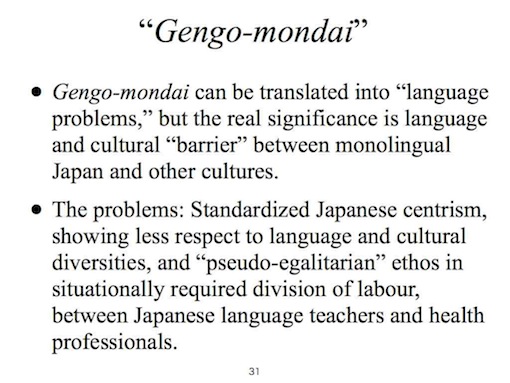 |
31.
“Gengo-mondai”
Gengo-mondai can be translated into “language problems,” but the real
significance is language and cultural “barrier” between monolingual
Japan and other cultures.
The problems: Standardized Japanese centrism, showing less respect to
language and cultural diversities, and “pseudo-egalitarian” ethos in
situationally required division of labour, between Japanese language
teachers and health professionals.
|
 |
32.
“Jinkō-mondai”
Japanese “Jinkō-mondai” can be translated as Demographic issues
connotating with population control policy without
immigration/emmigration policy after 1950s.
Population literally means; individual accounting, fertility and
mortality rates, biological and statistics phenomenon.
Demography literally means; demos = people, citizenry, masses, -graphy
= description, so political economic, and socio-political issues.
|
 |
33.
Asian Population Thesis
Hypothesis 1: It can be explained that Economic growth in Asia had been
outcome of “demographic bonus” - falling both fertility rates and
infant mortality rates makes reduction of proportion non productive
dependents. This spurs economic growth.
Hypothesis 2: Asian aged societies in future will lose economic growth
rates and eventually have social problems by “demographic onus”
|
 |
34.
Negative Demographic Issue and Technological Innovation in Future Asia
We Japanese had been benefitted from demographic bonus from 1950-1970s,
and we are suffered from our own demographic onus/burden from 1995 to
present.
On one side the demographic trends can be prospected, but we cannot
easily prospect technological innovations (especially on ICT,
Sustainable energy resources, and Robotics for social-welfare) ,
political structures in national level, and their interrelationships on
other side.
Many Asian countries have been benefitted from bonus from late 1960s/
beginning 1970s, but now our neighbor friends confront with the
beginning of demographic onus.
|
 |
35.
Key term: Healthy Aging Policy
Healthy Aging is worldwide consensus policy affirmed by many
international health promotion agencies, e.g.WHO. It is defined as
“processes through life‐span development, especially from adulthood to
late life, reflecting subjective physical, social, psychological, and
spiritual self‐actualizations within the context of individuals’
particular communities.”(A.E.Scharlach & K. Hoshino 2012)
The problem is far from “actual/real experience of each elderly
ordinary life of all over the world.”
|
 |
36.
Our Inquiry: Concluding Remarks
We are now conscious that the world people has confronted with aging
society. We also know aging process are various depending on
sociopolitical and cultural process.
We are now conscious that we need talk each other and share about
various coping ways rooted in each traditional and contemporary
cultures.
We are now conscious that we need remind the Alma Ata Declaration by
WHO(1978) that remarks the world community to protect and promote the
health of all people, Health For All. Coping with aging world also can
be applied Alma Ata philosophy.
|
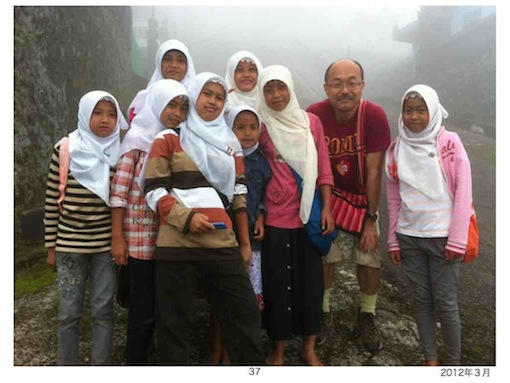 |
37.
With Students Kids in Java, Indinesia, March 2013
|
 |
38.
Talking aged society between Japan and Indonesia with Javanese people,
March 2013
|
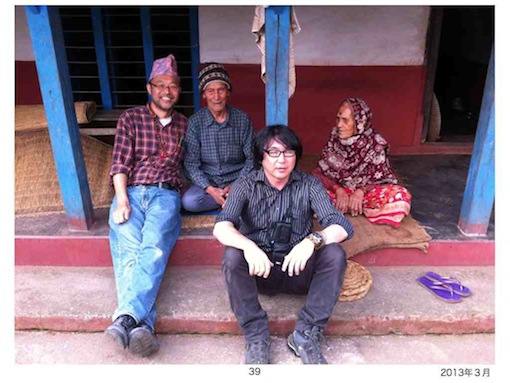 |
39.
Visiting to aged "empty nest" of Nepali parents, March 2013
|
 |
40.
Thank you for your attention
ขอขอบคุณสำหรับความสนใจของคุณ
|
![]()
![]()